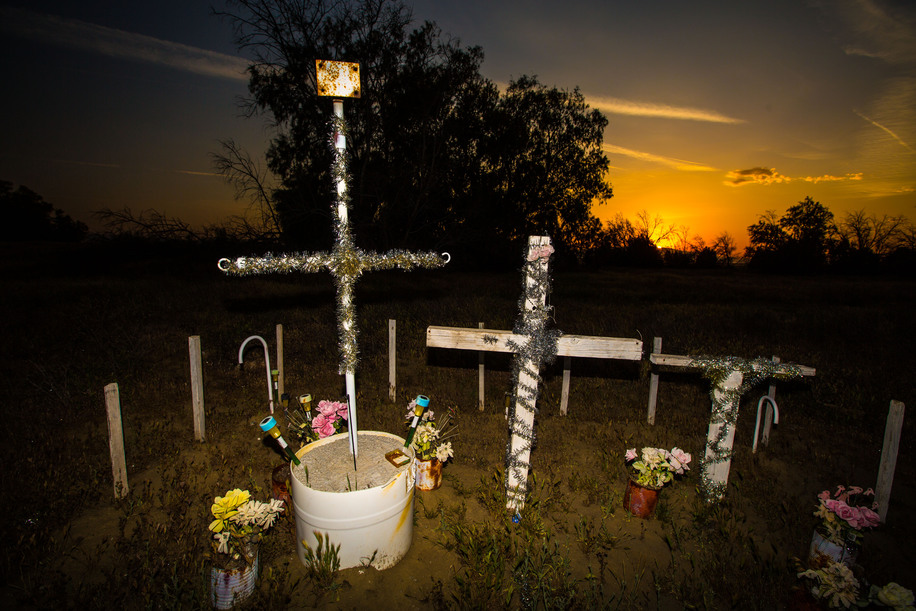

This shrine to Martha Zavala (19) and six other residents of Huron and nearby Avenal stands beside Lassen Avenue, about a mile north of the small, San Joaquin Valley town of Huron. As Martha and her childhood friend drove home from their shift at McDonald's, torrential rains caused the normally dry Arroyo Pasajero to wash out a bridge over Interstate-5 west of town. During a blinding rainstorm on March 10, 1995 Zavala and five others drove into the abyss. The shrine has been maintained for 23 years by relatives of those who died and marks the spot where Martha's body was recovered several days after the tragedy..
Death Shrines of Huron
Richard Street | California, United States
Photographer: Richard Street
Exhibit Title: Death Shrines of Huron
Location: California, United States
Death shrines dot this poor, San Joaquin Valley, California farm town. These shrines commemorate murdered gang members, innocent civilians, victims of domestic violence, and the massive carnage which occurs on the dangerous roads around town. For years, many stood along Lassen Avenue, the main street through town, and on Myrtle Avenue, in the El Porvenir Estates, and beside chain link fences separating the town from surrounding fields. Many have disappeared. No one seems to know why. Town leaders are often accused of removing them as an eyesore. But they stand as monuments to a town where no one participates in government and where witnesses refuse to testify out of fear of retribution. Drive by shootings meant to intimidate are common. Wounded citizens like "Big Worm" - shot a dozen times and paralyzed -- do not make it into the pages of the Fresno Bee. The latest shooting to be memorialized left 14 year-old Diego Perez dead at the hand of a 13-year-old classmate.
Richard Steven Street, Jon Lewis: Photographs of the California Grape Strike (University of Nebraska Press, 2013)
Street, Everyone Had Cameras: Photographers and Farmworkers in California (Univ. of Minnesota Press, 2008)
Street, Beasts of the Field: A Narrative History of California
Farmworkers, 1769-1913 (Stanford University Press, 2004)
Street, Photographing Farmworkers in California (Stanford University Press, 2004)
Street, Organizing for Our Lives: News Voices from Rural Communities (New Sage Press/California Rural Legal Assistance, Portland, 1992), Introduction by César Chávez.
Street, Kern County Diary: The Forgotten Photographs of Carleton E. Watkins, 1881-1888 (Bakersfield, Kern County Museum, 1983).
Street, “The Documentary Eye: How Economist Paul S. Taylor Pioneered Social Documentary Photography,” California magazine 120 (May/June 2009), 51-58
Street, “Delano Diary: The Visual Adventure and Social Documentary Work of Jon Lewis, Photographer of the Delano, California Grape Strike, 1966-1970,” Southern California Quarterly 91 (Summer 2009), 191-235.
Street, “Photographing from the bullpen on assignment, when César Chávez ended his fast at Forty Acres, August 21, 1988,” 77 Pacific Historical Review (Winter 2008), 151-153 (and photograph)
Street, “Leonard Nadel’s Photo Essay on Bracero Laborers in California,” Center 27: Record of Activities and Research Reports, June 2006-May 2007, National Gallery of Art, Center for the Advanced Study in the Visual Arts (Wash., DC, 2007), 152-155.
Street, “Poverty in the Valley of Plenty: The National Farm Labor Union, DiGiorgio Farms, and Suppression of Documentary Photography in California, 1947-66,” Labor History 48 (February 2007), 25-48.
Street, “The Photographer’s Double: The Photographer as Historian, the Historian as Photographer,” Visual Communication Quarterly 13 (Spring 2006), 66-89
Street, “Lange’s Antecedents: The Emergence of Social Documentary Photography of California’s Farmworkers,” Pacific Historical Review 75 (August 2006), 385-428.
Street, “Framing Farm Workers Through a Historian’s Lens,” The Chronicle of Higher Education, June 7, 2002, B13-15 reprinted in History News Network.
These images are part of a much larger project focused on life and labor in Huron and the west side of california's San Joaquin Valley.
Make Comment/View Comments